
THIS WEEK, WE ARE PLEASED TO HAVE ANNIE WAN, ARTIST AND ASSISTANT PROFESSOR OF THE ACADEMY OF VISUAL ARTS AT HONG KONG BAPTIST UNIVERSITY, JOIN OUR DISCUSSION ON HER JOURNEY TO BECOMING A CERAMIC ARTIST.
Dr. Henrietta Tsui-Leung: Henrietta
Annie Wan: Annie
Henrietta: How did you start your journey in art?
Annie: It was actually quite complicated. When I was young, my mother would always say “my daughter will be an artist one day” when she saw my artworks. I still remember these words to this day.
Although I majored in science throughout junior and secondary school, by the time I got to choose my major for tertiary education, I began to consider studying either fine arts at the Chinese University of Hong Kong (CUHK) or design at the Hong Kong Polytechnic University (PolyU). I thought studying design at PolyU would be the coolest thing. On the other hand, it was to my belief that studying fine arts at CUHK would automatically shape me into a teacher. Since I was reluctant to work in the education sector, I finally decided to pursue the Higher Certificate Studio Ceramics Course at PolyU.
Studying at CUHK for my bachelor’s degree was a very interesting experience for me. I was never an organized person and I did not have life plans. While I was taking some philosophy courses in PolyU, I began to think: if I am going to be a freelance designer anyway, shouldn’t I just apply to study at CUHK?
Henrietta: Were you a product designer?
Annie: It was textile design. After I got into CUHK, it was like I discovered a whole new world. From there, I gradually developed my artistic skills and eventually obtained my Master of Fine Arts.
While I was still in university, I began to gain some working experience by teaching ceramic studies part-time in CUHK, Hong Kong Art School and Hong Kong Baptist University. My Associate Professorship at HKBU’s Academy of Visual Arts was my first full-time job after I graduated from CUHK.
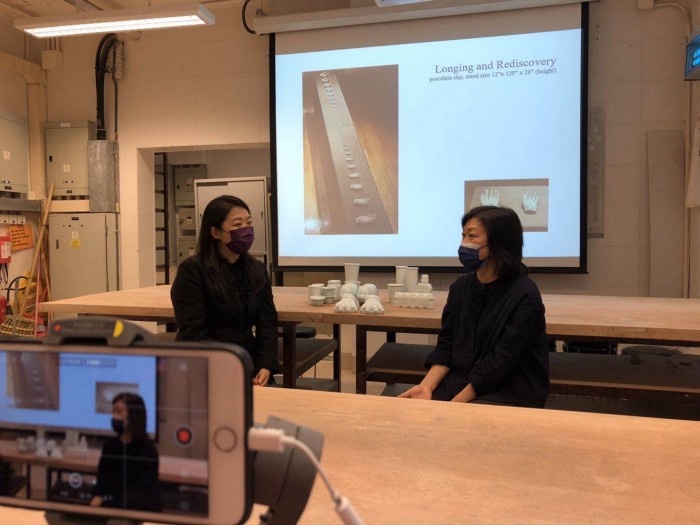
Image: Dr. Henrietta Tsui-Leung and artist Annie Wan (image courtesy of Ora-Ora and the artist)
I love the creating process. While undertaking my MA courses, my friends and I would discuss problems and difficulties relating to artistic creation during seminar classes. I remember times when my classmates would cry when discussing art. It shows how serious we were towards creating art. People never worried about potential working or studying problems, everyone was simply moving towards the same goal — perfecting their art. I was lucky enough to have opportunities that allow me to further my artistic development. Like I said, I am not a well-planned person, I never planned my career, I just followed my guts.
Henrietta: Can you find the “contemporary” in your ceramic artworks?
Annie: This “contemporary” of ceramics is something I always think about. For example, when I was in graduate school, I would always ask myself existential questions like “what is ceramics”? While I was lecturing on the cultural context of ceramics, I would tend to focus on the texture and scent of the ceramic works, which are some of their unique characteristics. As for the difference between ceramics and contemporary art, this is something I always think about. The kind of deliberation is also shown through my works. Ceramics is not only a material-based medium, it is also object-based. The final outcome of ceramics is usually an object as well. When thinking about the difference between ceramics and contemporary art, I would always ask whether craftsmanship is important and would divide this question into two parts: is the texture important; is the clay important? Nevertheless, I would never ignore the nature of ceramics while creating. I always strive to preserve its most natural state.
People used to ask me why I like to use children’s handprints as the theme of my works. I would tell them honestly, “it’s my own hand”. Since ceramic contracts during the heating process, when it repeatedly undergoes casting and heating, it shrinks even further. When I continuously repeated the process, I wondered if my hand can shrink to the size of a śarīra (a small bead-like crystal-shaped Buddhist relic). I took many tests and found that it maintained the shape of a hand even after the contraction. To me, it was a surprising finding.
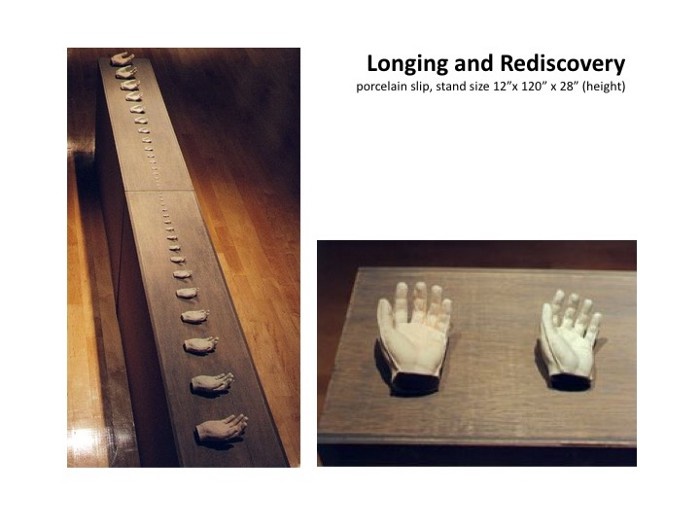
This piece of work was created while I was an artist-in-residence in Denmark. I am a fairly shy person, especially when I am in a new place. But I actually quite like that journey, it inspired me to develop my own way of working, whether outside or in my studio.
I have been thinking about the techniques of casting and moulding, and the effect they can achieve. This is related to the craftsmanship I mentioned earlier. Texture is very important in ceramics, but casting and moulding would negatively affect the texture. When you use readymades in cast and mould, you would incorporate its meaning into your own work. But at the same time, when I transform the object with other materials, like with clay, would I change its meaning? I always think about the transformation between objects and materials.
This piece of work was created because I found light shining through the window on the roof even though there was no electrical lighting on the roof at all. This mould is shaped like the light I saw through the window. When I casted and moulded this window, it was like I was moulding the light. I chose not to use plaster but clay and slapped it directly on the window. I then used the handbuilding technique and cropped out the shape of the light, transforming it into the artwork it is now.
There was a period of time when I mainly worked on casting and moulding. When I observe something inspiring, I would want to mould them and see their form afterwards.
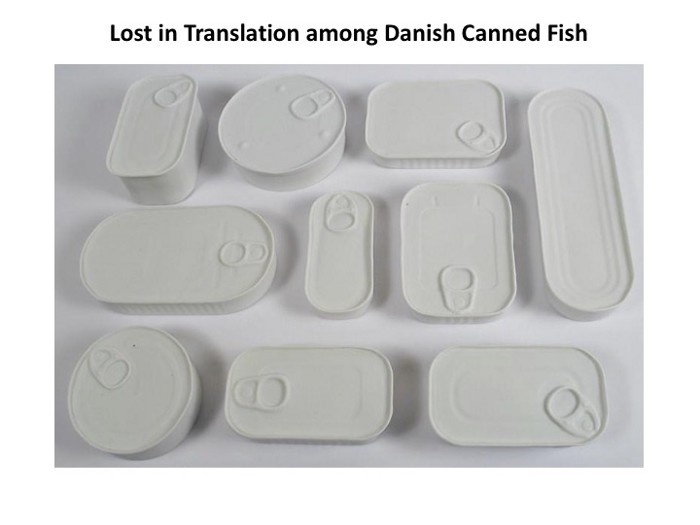
Image: Project — Lost in Translation among Danish Canned Fish (image courtesy of Ora-Ora and the artist)
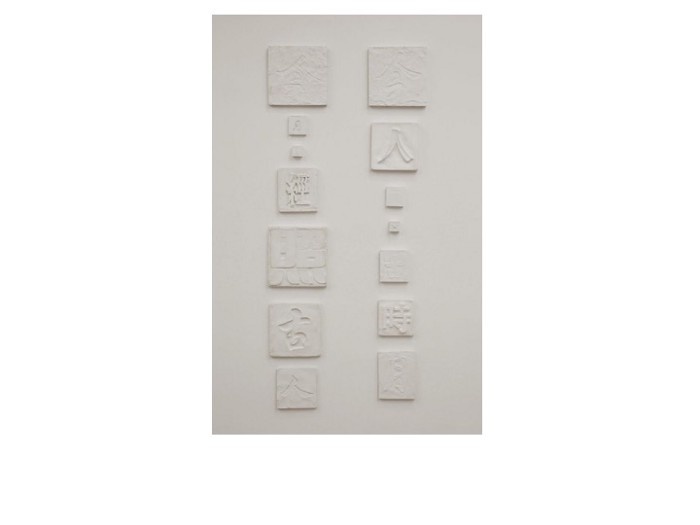
This was a fun project. It was created with the cooperation of international artists and 10 other local artists in Wan Chai. I saw a book of Tang poetry in a bookstore in Wan Chai featuring a sentence in Li Bai’s poem “Men today do not see the moon of old. Moon today once shone on men.” I immediately felt the connection between these two lines and Wan Chai. Wan Chai has undergone many transformations rapidly within just a few years. Since the poem is about “presence and absence”, I began to think about the things that were once present but now are gone. Because of this, I became inspired to explore the shops and streets in Wan Chai, acquired some textured shop signs and made impressions of them using clay. I even got questioned by the police as I had to work fast and quietly in the middle of the night with a ladder. This work is inspired by a public toilet sign and the sign of a flower shop.
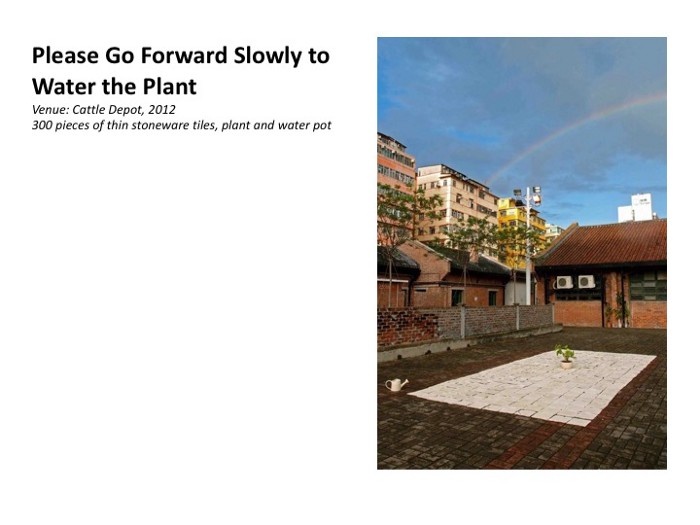
Image: Installation — Please Go Forward Slowly to Water the Plnat, Cattle Depot, 2012 (image courtesy of Ora-Ora and the artist)
I had a few ideas at first, but I wasn’t too sure of the outcome, so I just went with the flow. I made some thin slabs that were already fired and pieced them together according to the size of a unit in Nga Tsin Wai Tsuen. I then planted a pot of flowers in the middle and made a watering pot with ceramic. When you water the flower, you would have to step on the slabs and that would cause cracks on them. If you want the flower to blossom, you would have to water it at the cost of causing damage to something else. If you are not brave enough to do that, the plant would die. At first, I encouraged visitors to water the flower, but they were not willing to try. Yet, once they stepped on the slabs, they became very excited. Some jumped, some even danced. The sound of the cracking slabs denoted a sense of destruction.
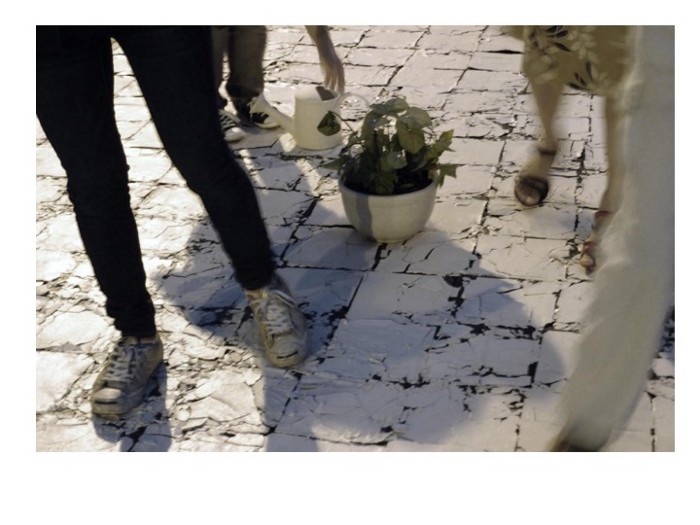
Image: Installation — Please Go Forward Slowly to Water the Plnat, Cattle Depot, 2012 (image courtesy of Ora-Ora and the artist)
I was travelling overseas when the Typhoon Signal №10 was hoisted in Hong Kong. I thought my work would be destroyed, as I thought everything would be blown into pieces by the typhoon. When I went to tidy up on the last day of the exhibition, I found out that it was still in the state as featured in this photo. I was so happy that I began running around the work.
I don’t prefer to impose self-important statements like “urbanization is bad”. I don’t like doing that.
Henrietta: Does this mean you would not impose a statement and then find evidence to support it?
Annie: Exactly, I like to express a thought or a revelation.
Henrietta: But this series did not undergo the firing process at the end.
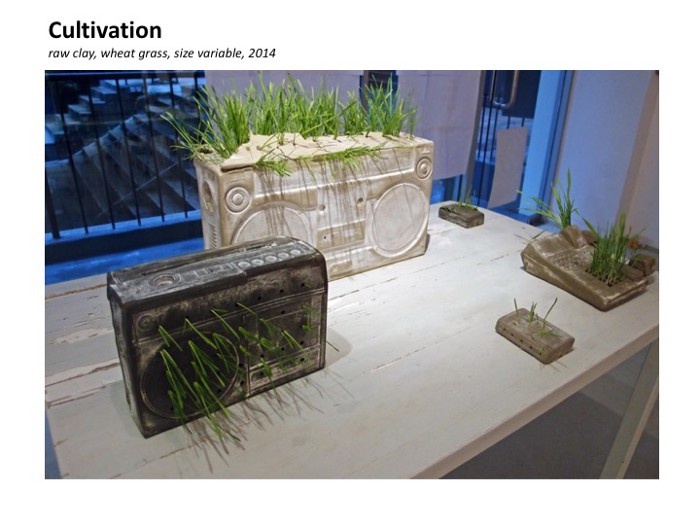
Annie: It was not fired, and it was not casted by plaster, so you can see some of the details are reversed. This work was created during Occupy Central in 2014. There was a lot of negativity in Hong Kong at that time, so I decided to create something more positive. I always find plants growing out of concrete, and this boombox (portable music player) is the first machine I bought with my own money. The work included a machine left by my father, which was the radio he used to listen to football matches. The objects are mostly related to sound. I made a box out of them and then planted the seed in there. The exhibition began with a box without a single piece of grass and it evolved gradually with the eventual growing and withering of the grass.
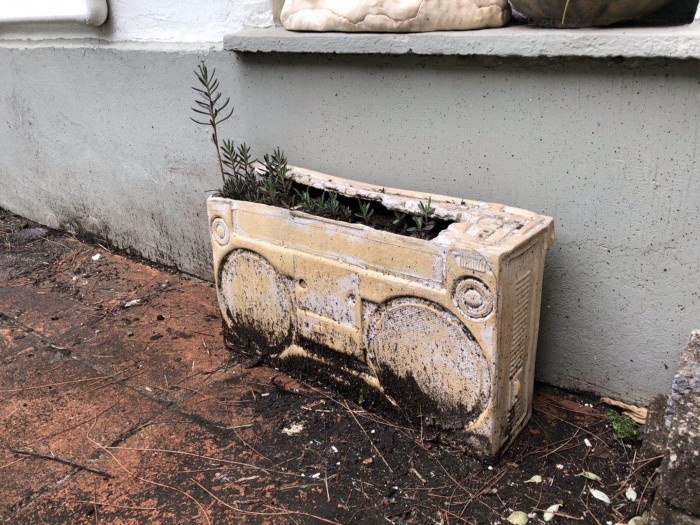
Image: Project — Cultivation (image courtesy of Ora-Ora and the artist)
I saw many small Japanese packages and I started to cast and mould them. In Japanese ceramic workshops, they usually use handbuilding and wheel techniques, so when they saw me casting and moulding readymade objects, they were very interested. My creation process would attract many observing onlookers as they were keen to judge the authenticity of the objects.
Henrietta: Because people are more familiar with readymades.
Annie: Yes, it is probably because people like to identify the real and fake objects hence the popularity. I transformed a museum into a department store, which is why it is named MEGartSTORE. I was in charge of making the food and drinks products, I took supermarket products and transferred them into the museum and arranged them according to the colours of the rainbow. I asked the marketing staff of City’super if I could do something like that and to my surprise, they were eager to accept.
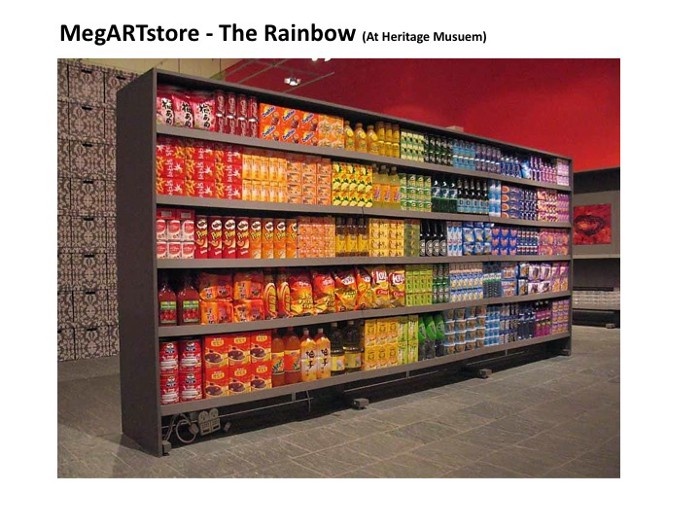
Image: MegARTstore (image courtesy of Ora-Ora and the artist)
After I arrived in Gwangju, I realised most of their products are colourful, and it reminded me of the work I have done and inspired me to expand the concept. The most satisfying part for me was that I was able to bring the artwork outside of the museum and transform it to become the work you now see in this photo. I got in contact with a ceramic master and he was willing to share his studio with us so we made our works there which were all in reverse. I bought many packages online to mimic products in a store. Then I found different stores and put the creations there.
Henrietta: This is very interesting.
Annie: But I was not able to mimic the selling part yet.
I experienced a lot of obstacles during that period of time. At first, I wanted to open a store opposite to Ping Shek Estate which was on tender by the Housing Department. We tried to apply for the tender but failed. Then I shared my idea with an uncle who works at a shop in Ping Shek, and he told me, “If you like, you can feature your work here in my shop”. I was so excited, I thought I could really put my work there. However, the uncle changed his mind and no longer wanted to work with us. I had to change plans immediately and therefore contacted a gallerist friend. He said he had an old gallery that he could lend me to finish my work. As a result, my work was exhibited in his Sheung Wan gallery. After that, I went back to the uncle and he finally allowed me to continue to work in his space. In the end, my work was exhibited in two places, and it went better than I expected.
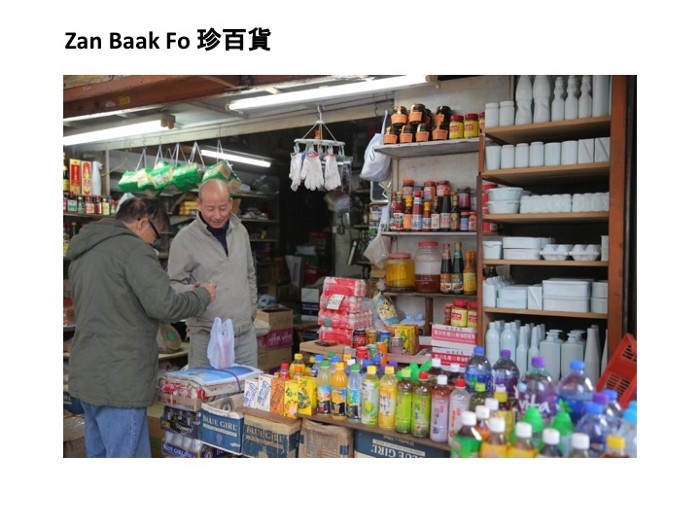
Henrietta: The works in Ping Shek can be bought?
Annie: Yes. I sold them.
Henrietta: Unbelievable! Why didn’t I go there? I bought all of these.
Annie: These are all from the Sheung Wan gallery. The works are marked at the price of the original objects, which created another meaning under the context of a gallery — that art can be sold at such low prices.
Henrietta: What did you expect from selling the works?
Annie: In one sentence, I haven’t yet digested the whole thing. It was interesting that people were so invested in my work and so eager to acquire them. People queued up for them in the early morning, some are even first-time collectors. People have different opinions on these works, and I found many photos on Facebook from this exhibition.
I didn’t know you back then.
Henrietta: Yes, we didn’t know each other, but we queued up to buy your works.
Annie: These works would be put back into the cupboard or fridge. Interestingly, the works are an extension of their original beings.
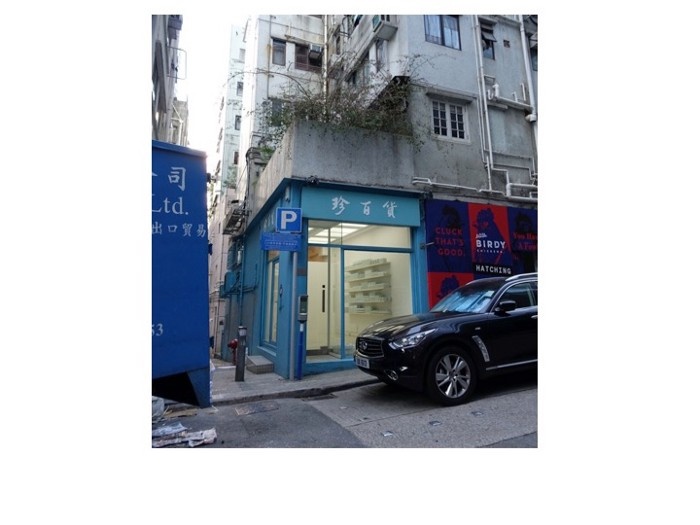
Annie: I thought a lot about the price, how the value of money can be transformed. I sometimes think, “Can love be transformed into money? Can sadness be transformed as a type of currency?” I would have ideas like that. My newest project is “Tung Zan Baa Fo”, which discusses questions like the transformation of values, how do we transform money into something humane?
Henrietta: “Tung Zan Baa Fo” is now exhibited in the Hong Kong Museum of Art which is newly reopened.
Annie: People would need to donate to get a receipt, before they can “adopt” a toy from this exhibition.
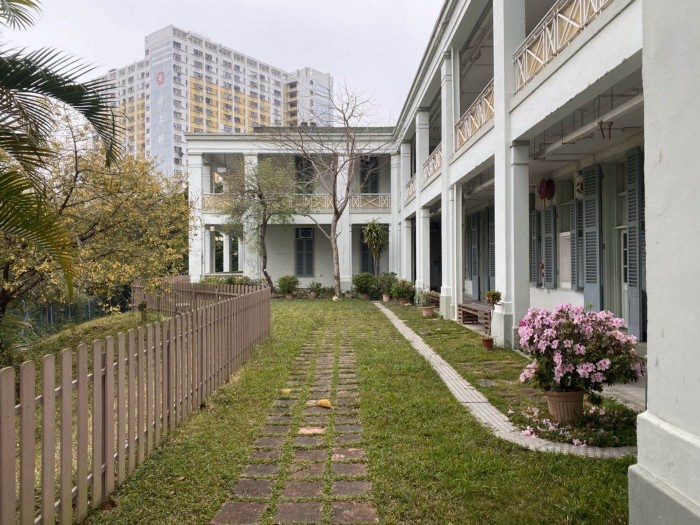
Image: Academy of Visual Arts at Hong Kong Baptist University (image courtesy of Ora-Ora and the artist)
ABOUT ORA-ORA LIVE
Each week, Ora-Ora’s founder Dr. Henrietta Tsui-Leung will speak with various members of the art community — including artists, curators, academics and other professionals working in the cultural sector — to address topics of interest related but not limited to Hong Kong’s art and cultural scene. Arranged in fifteen to thirty-minute segments, the series aims to be an outlet for creativity and a means to connect with peers who share similar interests. The episodes will also available live on Ora-Ora’s Instagram (@galerieoraora), Facebook (Galerie Ora-Ora) and later on Ora-Ora’s YouTube channel.